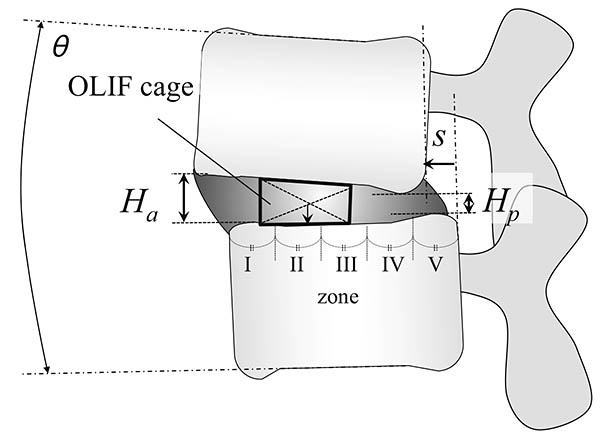- 著者
- Yasuhiro Shiga Sumihisa Orita Kazuhide Inage Jun Sato Kazuki Fujimoto Hirohito Kanamoto Koki Abe Go Kubota Kazuyo Yamauchi Yawara Eguchi Masahiro Inoue Hideyuki Kinoshita Yasuchika Aoki Junichi Nakamura Yusuke Matsuura Richard Hynes Takeo Furuya Masao Koda Kazuhisa Takahashi Seiji Ohtori
- 出版者
- The Japanese Society for Spine Surgery and Related Research
- 雑誌
- Spine Surgery and Related Research (ISSN:2432261X)
- 巻号頁・発行日
- vol.1, no.4, pp.197-202, 2017-10-20 (Released:2017-11-27)
- 参考文献数
- 24
- 被引用文献数
- 22 25
Introduction: Oblique lateral interbody fusion (OLIF) can achieve recovery of lumbar lordosis (LL) in minimally invasive manner. The current study aimed to evaluate the location of lateral intervertebral cages during OLIF in terms of LL correction.Methods: The subjects were patients who underwent OLIF for lumbar degenerative diseases, including lumbar spinal stenosis, spondylolisthesis, and discogenic low back pain. Their clinical outcome was evaluated using visual analogue scale on lower back pain (LBP), leg pain and numbness. The following parameters were retrospectively evaluated on plain radiographic images and computed tomography scans before and at 1 year after OLIF: the intervertebral height, vertebral translation, and sagittal angle. The cage position was defined by equally dividing the caudal endplate into five zones (I to V), and its association with segmental lordosis restoration was analyzed. Subjects were also evaluated for a postoperative endplate injury.Results: Eighty patients (121 fused levels) with lumbar degeneration who underwent OLIF were included. There were no significant specific distribution in preoperative disc pathology such as disc angle, height, and translation. After OLIF, sagittal alignment was improved with an average correction angle of 3.8º at the instrumented segments in a level-independent fashion. All cases showed significant improvement in clinical outcomes, and had improvement in the radiological parameters (P<0.05). A detailed analysis of the cage position showed that the most significant sagittal correction and the most postoperative endplate injuries occurred in the farthest anterior zone (I). Cages with a 12-mm height were associated with more endplate injuries compared with shorter cages (8 or 10 mm).Conclusions: OLIF improves sagittal alignment with an average correction angle of 3.8º at the instrumented segments. We suggest that the optimal cage position for better lordosis correction and the fewest endplate injuries is zone II with a cage height of up to 10 mm.
- 著者
- Kana Kurokawa Munechika Hara Shin-ichiro Iwakami Takuya Genda Naoko Iwakami Yosuke Miyashita Masahiro Fujioka Shinichi Sasaki Kazuhisa Takahashi
- 出版者
- The Japanese Society of Internal Medicine
- 雑誌
- Internal Medicine (ISSN:09182918)
- 巻号頁・発行日
- vol.58, no.22, pp.3283-3287, 2019-11-15 (Released:2019-11-15)
- 参考文献数
- 23
- 被引用文献数
- 13 15
The anti-programmed cell death-1 protein monoclonal antibody, pembrolizumab is an immune checkpoint inhibitor. While it improves the prognoses of patients with advanced non-small-cell lung cancer, it has been reported to induce various kinds of immune-related adverse events, including hepatotoxicity. Despite the frequency of hepatotoxicity, there is only limited information available regarding the pathophysiology and treatment. We herein report a 48-year-old man with lung adenocarcinoma who was treated with pembrolizumab and developed cholestatic liver injury. In this case, the importance of evaluating the histology of hepatotoxicity and the effectiveness of ursodeoxycholic acid for cholestatic liver injury is indicated.
- 著者
- Gen Inoue Takashi Kaito Yukihiro Matsuyama Toshihiko Yamashita Mamoru Kawakami Kazuhisa Takahashi Munehito Yoshida Shiro Imagama Seiji Ohtori Toshihiko Taguchi Hirotaka Haro Hiroshi Taneichi Masashi Yamazaki Kotaro Nishida Hiroshi Yamada Daijiro Kabata Ayumi Shintani Motoki Iwasaki Manabu Ito Naohisa Miyakoshi Hideki Murakami Kazuo Yonenobu Tomoyuki Takura Joji Mochida
- 出版者
- The Japanese Society for Spine Surgery and Related Research
- 雑誌
- Spine Surgery and Related Research (ISSN:2432261X)
- 巻号頁・発行日
- pp.2020-0083, (Released:2020-11-20)
- 被引用文献数
- 2
Introduction: Chronic low back pain (CLBP) is a leading cause of disability, yet there is limited high-quality evidence to identify the most suitable pharmacological therapy. The purpose of this Japanese nationwide, multicenter, prospective study was to compare the effectiveness of four representative drug therapies—acetaminophen, celecoxib, loxoprofen, and a tramadol and acetaminophen (T+A) combination drug—to establish evidence for a drug of choice for CLBP.Methods: Patients with CLBP (N = 471) received one of the four treatments and were evaluated, prospectively and comprehensively, once every month for six months using a visual analog scale (VAS) for LBP, the Japanese Orthopedic Association (JOA) score, the JOA Back Pain Evaluation Questionnaire (JOABPEQ), the Roland–Morris Disability Questionnaire (RDQ), the EuroQol five-dimensions three-levels (EQ-5D-3L), and the Short Form-8 item health survey (SF-8). We conducted multivariable linear regression analyses of the four drugs at 1 and 6 months after drug allocation. Differences with P < 0.05 were considered statistically significant.Results: Patients who received acetaminophen showed a significant improvement from baseline in the mental health subscale of the JOABPEQ at one month (P = 0.02) and the JOA score at six months (P < 0.01). None of the other outcome measures among the four drugs differed significantly. Across groups, all outcome measures, except the mental component summary (MCS) score of the SF-8, improved equivalently, although most measurements showed no obvious cumulative effect over six months. The MCS score of the SF-8 decreased gradually over six months in all groups.Conclusions: Most of the outcome measures among the treated groups were not significantly different, indicating similar treatment effects of the four drugs for CLBP. Our study indicated the limit of each outcome measure for evaluating the patient status, suggesting that a single outcome measure is insufficient to reflect treatment effectiveness.
